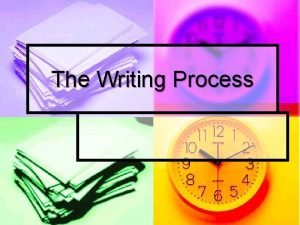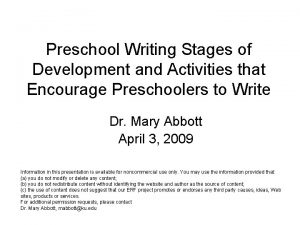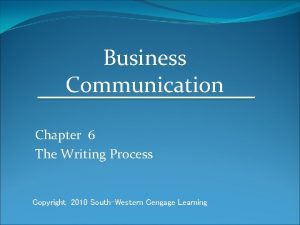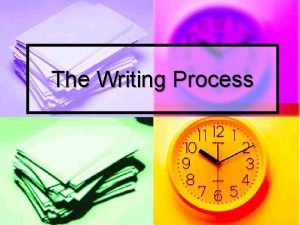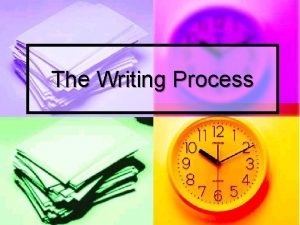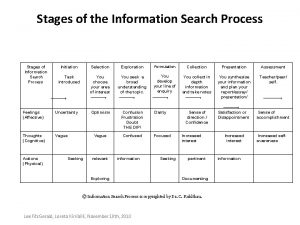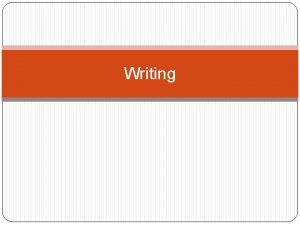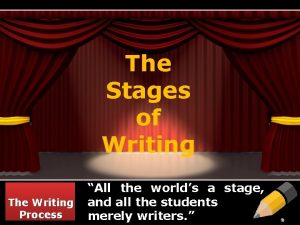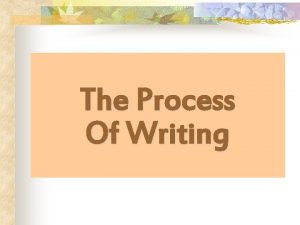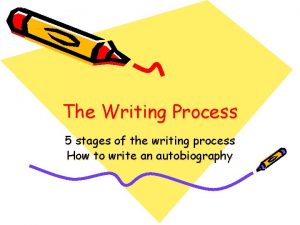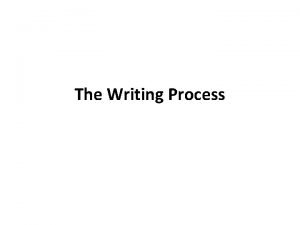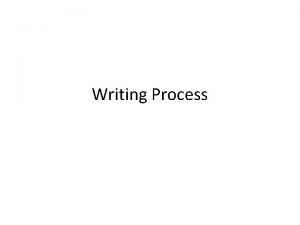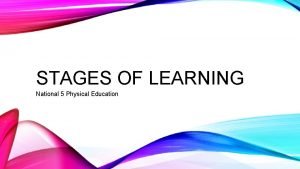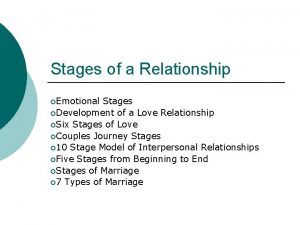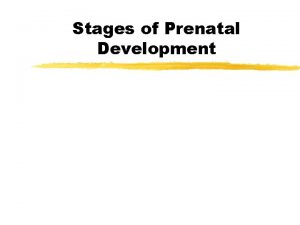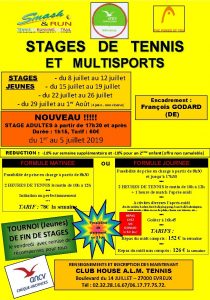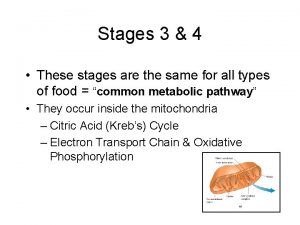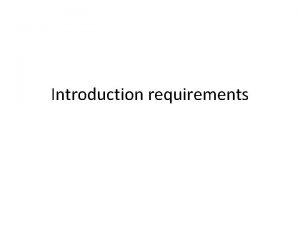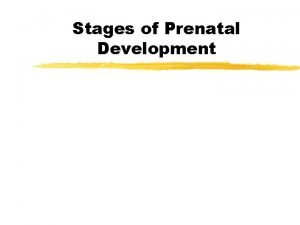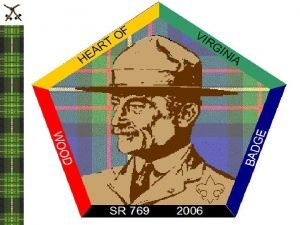The Writing Process Stages of the Writing Process































- Slides: 31

The Writing Process

Stages of the Writing Process n There are several stages to the Writing Process. Each stage is essential. Prewriting l Writing (Drafting) l Revising l Editing l

I. Prewriting Choose/narrow your topic n Determine your n n Audience n Purpose n Tone n Point-of-view n Tense Explore your topic n Make a plan n

Choose/Narrow Your Topic n Your topic should pass the 3 question test: 1. Does it interest me? 2. Do I have something to say about it? 3. Is it specific?

Determine Your Purpose n n Purpose is the reason you are writing. Whenever you write, you always have a purpose. Most writing fits into one of 3 categories: l l l n Expressive Writing Informative Writing Persuasive Writing More than one of these may be used, but one will be primary.

Determine Tense n Tense is the voice you use to designate the time of the action or state of being. Present tense l Past tense l Future tense l

Explore Your Topic n Pre-writing Techniques: l l l Brainstorming/Listing Freewriting Clustering/Mapping Questioning Discussing Outlining

Make a Plan n Before you begin drafting your essay, you should make a plan (a roadmap). l Review, evaluate, and organize ideas written in your pre-writing; then make a plan for your essay’s n Thesis statement n Support n Order n Structure

Thesis Statement n The thesis statement expresses the MAIN IDEA of your essay, the central point that your essay develops/supports.

Thesis continued. . . n Your thesis SHOULD: Accurately predict your essay’s direction, emphasis, and scope l Make no promises that the essay will not fulfill l Be direct and straightforward l NOT be an announcement, statement of opinion, or statement of fact. l

Support n Be sure to evaluate the information in your prewriting carefully in order to choose the best support for your topic. Primary Support—major ideas or examples that back up your main points l Secondary Support—details which further explain your primary support l

Support continued. . . n Basics of good support Relates to main point l Considers readers, i. e. provides enough information l Is detailed and specific l

Order The Order is the sequence in which you present your ideas. n There are 3 types of order: n Time (chronological) order l Space order l Emphatic order (order of importance: least-to-most, most-to -least) l

Structure/Organization n n Consider how your essay will be organized; then create an Outline. Sample Outline of standard 5 -paragraph essay: A. B. C. D. E. Introduction Body Paragraph 1 Body Paragraph 2 Body Paragraph 3 Conclusion

II. Writing n During the Writing Stage, you should Create your essay’s Title l Compose a draft l n. A Draft is the first whole version of all your ideas put together; it’s a “dress rehearsal. ” n You should plan to revise your Draft several times throughout the writing process.

Creating Your Title n Your essay’s title should: l l n Be original Be a reasonable length Reflect your topic Be lively and attention-getting Your title should NOT: l l Be generic/repeat the assignment Be in ALL CAPS Be in boldface, “quotation marks, ” underlined, or italicized Be followed by a period

Titles, continued n Capitalization Rules for Titles: Always capitalize the first letter of the first word and the last word. l Capitalize the first letter of each “important” word in between the first and last words. l n Do not capitalize articles (a, an, the) n Do not capitalize coordinating conjunctions (and, but, or, etc. ) n Do not capitalize prepositions (on, at, in, off, etc. )

Writing a Draft n Basics of a good draft: Has a fully developed introduction and conclusion l Has fully developed body paragraphs, each containing a topic sentence, at least two examples, and detailed support l Follows standard structure and uses complete sentences l

Write Your Introduction n Your introductory paragraph should do the following: Be a minimum of 4 -6 sentences l Tell the audience what to expect from your discussion (thesis) l Move from general to specific, with thesis as the last sentence in the intro l Get the reader’s attention l Set the tone for the rest of the essay l

Introduction, continued n Strategies for developing an Introduction include Providing background information l Telling a personal anecdote l Beginning with a quotation l Using an opposite l Asking a question l

Write Your Body Paragraphs Each body paragraph should develop one of the specific points mentioned in thesis. n Each BP should contain: n Topic Sentence—main idea of BP l Primary Support—examples l Secondary Support—details l

Body Paragraphs: Topic Sentence n n A Topic Sentence expresses the main idea of the body paragraph. Begin each body paragraph with a Topic Sentence that l l l Narrows the focus of the paragraph Accurately predicts the direction of the paragraph Refers back to the Thesis statement

Body Paragraphs continued n Body paragraphs must have Unity—everything refers back to main point l Support—examples and details l Coherence—all points connect to form a whole; one point leads to another l

Body Paragraphs: Unity n Unity is achieved when everything refers back to the main point ALL SENTENCES SHOULD RELATE BACK TO TOPIC SENTENCE & THESIS. l Do not include any ideas that are irrelevant or off-topic. l

Body Paragraphs: Support n n n Support is achieved through adequate examples and details. Each body paragraph should include at least two examples to support the main idea of the paragraph. Each example should include at least one specific detail that further illustrates the point.

Body Paragraphs: Coherence is achieved when all points connect to form a whole; one point leads to another. n Coherence is mainly achieved through the use of transitions. n l Transitions—words & phrases which connect your sentences so that your writing flows smoothly.

Write Your Conclusion n The concluding paragraph should Contain a minimum of 4 sentences l Refer back to the main point, but not simply repeat thesis l Make an observation on what is written l NOT introduce any new ideas l Create a sense of closure l

III. Revising n n Revising is finding & correcting problems with content; changing the ideas in your writing to make them clearer, stronger, and more convincing. Revising looks at the “Big Picture”— the Idea level.

Revision Tips Take a break from your draft before attempting to revise. n Read your draft out loud and listen to your words. n Imagine yourself as your reader. n Look for consistent problem areas. n Get feedback from peers. n Get help from a tutor! n

IV. Editing is finding and correcting problems with grammar, style, word choice & usage, and punctuation. n Editing focuses on the “Little Picture”—Word level. n

Editing Tips Work with a clean printed copy, double-spaced to allow room to mark corrections. n Read your essay backwards. n Be cautious of spell-check and grammar-check. n Read your essay out loud. n Get feedback from peers. n Work with a tutor! n
 5 stages of writing process
5 stages of writing process Stages of the writing process
Stages of the writing process Stages of emergent writing
Stages of emergent writing Stages of writing preschool
Stages of writing preschool Business communication chapter 6
Business communication chapter 6 Hát kết hợp bộ gõ cơ thể
Hát kết hợp bộ gõ cơ thể Bổ thể
Bổ thể Tỉ lệ cơ thể trẻ em
Tỉ lệ cơ thể trẻ em Voi kéo gỗ như thế nào
Voi kéo gỗ như thế nào Glasgow thang điểm
Glasgow thang điểm Hát lên người ơi alleluia
Hát lên người ơi alleluia Các môn thể thao bắt đầu bằng từ đua
Các môn thể thao bắt đầu bằng từ đua Thế nào là hệ số cao nhất
Thế nào là hệ số cao nhất Các châu lục và đại dương trên thế giới
Các châu lục và đại dương trên thế giới Công thức tiính động năng
Công thức tiính động năng Trời xanh đây là của chúng ta thể thơ
Trời xanh đây là của chúng ta thể thơ Mật thư tọa độ 5x5
Mật thư tọa độ 5x5 Làm thế nào để 102-1=99
Làm thế nào để 102-1=99 độ dài liên kết
độ dài liên kết Các châu lục và đại dương trên thế giới
Các châu lục và đại dương trên thế giới Thể thơ truyền thống
Thể thơ truyền thống Quá trình desamine hóa có thể tạo ra
Quá trình desamine hóa có thể tạo ra Một số thể thơ truyền thống
Một số thể thơ truyền thống Cái miệng nó xinh thế
Cái miệng nó xinh thế Vẽ hình chiếu vuông góc của vật thể sau
Vẽ hình chiếu vuông góc của vật thể sau Thế nào là sự mỏi cơ
Thế nào là sự mỏi cơ đặc điểm cơ thể của người tối cổ
đặc điểm cơ thể của người tối cổ Ví dụ về giọng cùng tên
Ví dụ về giọng cùng tên Vẽ hình chiếu đứng bằng cạnh của vật thể
Vẽ hình chiếu đứng bằng cạnh của vật thể Phối cảnh
Phối cảnh Thẻ vin
Thẻ vin
